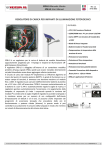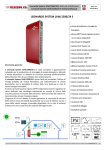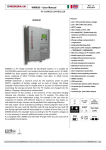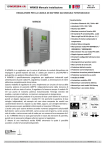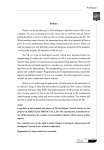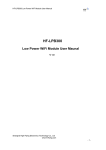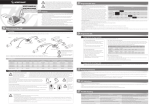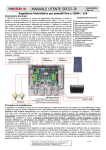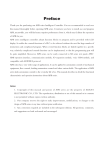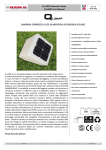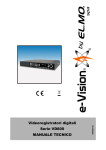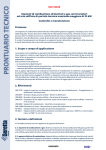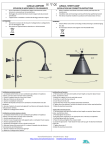Download regolatore di carica per impianti di illuminazione
Transcript
SPB-LS-GSM Manuale installazione Rev. 1.3 09-04-2014 REGOLATORE DI CARICA PER IMPIANTI DI ILLUMINAZIONE FOTOVOLTAICI CON CONTROLLO GSM FEATURES: • 12V / 24V tensione di batteria • 225W/450W max PV per sistemi 12V/24V • Carica MPPT con tensione del modulo fino a 100V • Diodo di blocco integrato • Batterie Sealed or Flooded Lead Acid • Compensazione in temperature della tensione di carica • Protezione di Low Battery SPB-LS/GSM è un regolatore per la carica di batterie da modulo fotovoltaico appositamente progettato per l’impiego in impianti di illuminazione offgrid (lampione fotovoltaico). Grazie al modem GSM integrato, il regolatore SPB-LS/GSM può essere controllato da remoto attraverso l’applicazione web residente sul server WesternCo. Almeno una volta al giorno il regolatore apre una connessione GPRS verso il server WesternCo e scarica i dati di funzionamento giornalieri. Sul server WesternCo è presente una applicazione (WCloud) che permette all’utente di analizzare i dati raccolti giornalmente dai propri lampioni durante il funzionamento, segnala eventuali anomalie o malfunzionamenti del regolatore e per permette all’utente di modificare le impostazioni di funzionamento del lampione come il numero di ore di accensione per notte e la soglia di lowBattery. Più avanti in questo manuale sarà spiegato meglio il funzionamento del sistema di controllo remoto. Il regolatore SPB-LS/GSM è alloggiato all’interno di un contenitore metallico protetto all’acqua (grado IP66), quindi può essere installato direttamente sul palo fotovoltaico senza dover aggiungere ulteriori protezioni. Il circuito di carica dal modulo PV implementa un efficiente algoritmo di ricerca del punto di massima potenza (MPPT), in grado di funzionare su un esteso campo di tensioni; è ammessa una tensione massima sul modulo fino a 100V. Il regolatore può caricare indifferentemente batterie al piombo sia a 12V che a 24V; all’accensione l’SPB-LS/GSM riconosce automaticamente se la batteria è a 12V o 24V e automaticamente regola le soglie di ricarica. Il regolatore gestisce automaticamente l’accensione e lo spegnimento della lampada; al crepuscolo (si rivela i crepuscolo quando la tensione del modulo PV scende sotto la soglia Vnight) il regolatore accende la lampada e la mantiene accesa per un numero di ore configurabili dall’utente (l’impostazione di default è di 8 ore, ma è configurabile dall’utente anche da remoto). Si possono anche impostare dei programmi di accensione lampada che prevedono delle ore di funzionamento a potenza ridotta (dimmer) in questo modo si può controllare in modo accurato il consumo della lampada in modo che rientrino nei vincoli di dimensionamento del sistema stad-alone. • Protezione di Over-temperature • Protezione di Overload • Protezione inversione polarità batteria • Controllo remote attraverso modem GSM • Comanda l’accensione della lampada a flusso pieno e a flusso ridotto • IP66 per applicazioni all’esterno This document is the property of WESTERN CO. Srl - All rights are reserved - Reproduction and use of information contained within this document is forbidden without the written consent of WESTERN CO. Srl 1 SPB-LS-GSM Manuale installazione Rev. 1.3 09-04-2014 Wiring Fig. 2 Wiring scheme This document is the property of WESTERN CO. Srl - All rights are reserved - Reproduction and use of information contained within this document is forbidden without the written consent of WESTERN CO. Srl 2 SPB-LS-GSM Manuale installazione Rev. 1.3 09-04-2014 Visualizzazioni e protezioni: Led PV Verde Funzionalità Il numero di lampeggi effettuati indica l’’intensità di corrente dal modulo fotovoltaico. 1 flash con pausa di 4,3 sec.: 0,5A < PV current < 1,5A 2 flash con pausa di 4,3 sec.: 1,5A < PV current < 2,5A e cosi via… …valori intermedi… 13 flash con pausa di 4,3 sec.: 12,5A < PV current < 13,5A Led Status Funzionalità Rosso Led 12/24 Funzionalità Verde Indica lo stato del sistema Se sempre acceso indica un’anomalia del sistema che richiede un reset. 1 flash ogni 2,2 secondi: protezione di Low-Battery attiva; carico disattivato; occorre attendere che il modulo PV ricarichi la batteria dopodiché la protezione si disattiva. (condizione di normale funzionamento) 2 flash ogni 2,2 secondi: protezione di sovraccarico attiva; carico disattivato; dopo circa due minuti si autoripristina esegue tre tentativi in sequenza dopodiché aspetterà la notte successiva per riprovare. 3 flash ogni 2,2 secondi: protezione di sovratemperatura; carico disattivo e circuito di ricarica disattivato; occorre attendere che la temperatura interna al contenitore diminuisca dopodiché la protezione si disattiva. 4 flash ogni 2,2 secondi: protezione di sovratensione; circuito di ricarica disattivato; la protezione si disattiverà quando la tensione di batteria rientra nel range operativo. Indica la tensione nominale di funzionamento del sistema Led Load giallo Oltre all’indicazione della tensione nominale di funzionamento del sistema, se ogni 4,3sec si spegne per un attimo indica che la sonda NTC e disconnessa. La Vch equivale a quella per 60°C Quando acceso indica che la lampada (load) è alimentata. Led Dimmer giallo Quando acceso indica che la lampada è in riduzione di flusso Funzionamento: L’ SPB-LS/GSM è un regolatore di carica da moduli fotovoltaici per batterie elettrochimiche al piombo di tipo ermetico (SEAL) o ad acido libero (FLOOD). In fig. 1 è riportato uno schema di principio. (1)-Circuito di ricarica: adatta la VPAN e la IPAN (rispettivamente tensione e corrente del modulo SPB-LS/GSM 1 fotovoltaico) in modo da ricercare la condizione in cui IP AN IBATT MPPT la potenza erogata dal modulo PV è massima, realizzando quello che nella letteratura tecnica è indicato con la sigla MPPT (Maximum Power Point 4 Tracking). Inoltre gestisce la ricarica della batteria MICROCON TROL LER VP AN V BATT V L OAD riducendo la corrente erogata verso la batteria nelle condizioni in cui la tensione VBATT supera la sua D IMMER 3 2 tensione di ricarica (VCH). (2)-Diodo di blocco: serve ad evitare che durante la ILO AD notte, quando il modulo fotovoltaico non è illuminato Fig. 1 Schema di questo possa assorbire corrente dalla batteria. principio il programma impostato dall’utente, comanda (3)-Circuito per il controllo del carico: accende o spegne il carico secondo la segnalazione Dimmer, e provvede al distacco del carico in caso di batteria scarica o sovraccarico. (4)-Microcontrollore: controlla l’intero circuito, misura le correnti e tensioni del modulo della batteria e del carico, esegue l’algoritmo MPPT. This document is the property of WESTERN CO. Srl - All rights are reserved - Reproduction and use of information contained within this document is forbidden without the written consent of WESTERN CO. Srl 3 SPB-LS-GSM Manuale installazione Rev. 1.3 09-04-2014 Scelta del modulo fotovoltaico: Il regolatore di carica SPB-LS/GSM, grazie al circuito di ricarica con MPPT, permette di impiegare una ampia gamma di moduli fotovoltaici garantendo lo sfruttamento ottimale di tutta la potenza. Il modulo PV va scelto a seconda della tensione nominale della batteria e rispettando i vincoli dell’ingresso pannello del SPB-LS/GSM: massima tensione a circuito aperto: 100V e massima potenza di pannello 220W con batteria a 12V e 440W con batteria 24V. Tensione nominale Caratteristiche moduli PV batteria Vmp: tensione alla massima potenza a T=25°C > 15,0V VOC: tensione circuito aperto a T=-10°C <100V IPAN Tensione nominale PMAX: massima potenza a 25°C < 225W Consigliamo moduli al silicio mono o poly-cristallino con numero di celle da minimo 36 a massimo 144 celle. batteria 12V Vmp: tensione alla massima potenza a T=25°C > VPAN 30,0V VOC: tensione circuito aperto a T=-10°C <100V Vmp VOC Tensione nominale PMAX: massima potenza a 25°C < 450W batteria 24V Consigliamo moduli al silicio mono o polycristallino con numero di celle da minimo 72 a massimo 144 celle. Configurazione modem GSM e installazione SIM Per il corretto funzionamento del controllo remoto si deve installare all’interno del regolatore SPB-LS-GSM una sim (dimensioni standard 15x25mm) GSM con due caratteristiche: 1. Abilitata ad effettuare connessioni GPRS (l’operatore deve fornire l’impostazione dell’APN), 2. Abilitata a ricevere/inviare SMS. Non è necessario invece che la sim sia abilitata a mandare e ricevere telefonate. I’SPB-LS-GSM esegue giornalmente una connessione GPRS nella quale scambia con il server una quantità massima di dati pari a 16Kbyte per un massimo volume di traffico al mese pari a 500Kbyte. Si consiglia di acquistare una sim card che abbia una tariffa appropriata a questo volume di dati; ad esempio esistono operatori che presentano tariffe inferiori a 1,00 € al mese per ogni Mbyte di traffico GPRS. Contattare la Western Co per consigli sulla scelta dell’operatore e della tariffa appropriata al sistema. Perché il modem interno al regolatore SPB-LS-GSM funzioni correttamente è necessario configurare l’APN (impostazione che deve essere fornita dall’operatore della SIM scelta) e deve essere eseguita in fabbrica dalla WesternCo. Sarà necessario al momento dell’ordine del prodotto comunicare alla WesternCo il corretto APN da impostare nel modem GSM. Qualora fosse necessario, la WesternCo è in gado di modificare da remoto, mandando al modem GSM un opportuno SMS, l’impostazione dell’APN. This document is the property of WESTERN CO. Srl - All rights are reserved - Reproduction and use of information contained within this document is forbidden without the written consent of WESTERN CO. Srl 4 SPB-LS-GSM Manuale installazione Rev. 1.3 09-04-2014 Di seguito sequenza immagini per installazione SIM card nel modem GSM: Aprire sportello SIM Inserire la sim nella slitta Chiudere sportello SIM Installazione regolatore SPB-LS/GSM 1)Posizionare il regolatore sul palo fotovoltaico, con i pressa cavo rivolti verso il basso. Se avete acquistato una struttura testa-palo della Western Co tipo WTP55 o WTP20, questa è già predisposta per alloggiare il regolatore SPB-LS/GSM. 2)Eseguire i cablaggi della lampada, del modulo PV e della batteria come nello schema a pag.2. Insieme al regolatore SPB-LS/GSM sono forniti in dotazione tutti i cavi necessari a fare i collegamenti interni del lampione PV. 3) Posizionare l’antenna del modem GSM al di fuori del box metallico contenente le batterie. L’antenna ha una base magnetica che ne facilita l’installazione. 4)Deve essere impostata la configurazione per le batterie. Se la batteria è installata a più di 3mt dal regolatore di carica esso avrà un errore nella misura della tensione di batteria dovuto alla caduta di tensione sui cavi. Per evitare questo inconveniente l’SPB-LS/GSM, basandosi sulla corrente di ricarica, implementa un algoritmo che compensa la caduta di tensione sui cavi di batteria. Questo algoritmo è attivo se lo switch No. 5 è settato in posizione OFF ed è disattivo se lo switch No 5 è in posizione ON (settaggio di fabbrica). Se la batteria è stata installata in cima al palo, vicino al regolatore di carica, non si deve spostare lo switch No5 in OFF. This document is the property of WESTERN CO. Srl - All rights are reserved - Reproduction and use of information contained within this document is forbidden without the written consent of WESTERN CO. Srl 5 SPB-LS-GSM Manuale installazione Rev. 1.3 09-04-2014 Ulteriori settaggi, come la tensione di carica (Vch), la massima profondità di scarica della batteria (VLB) e le ore di accensione della lampada per notte saranno impostate da remoto la prima volta che il regolatore si connette al server Western Co. 5)Eseguire il collaudo del modem GSM. Premere per circa 1 secondo il pulsante TEST, e una volta acceso il led rosso di segnalazione rilasciare il pulsante TEST; in questo modo si avvia la procedura di connessione e scarico dei dati verso il server WesternCo che impiegare all’incirca 2/3 minuti. La procedura è in corso fintanto che il led verde lampeggia, ed è finita quando il led verde è spento. La procedura ha avuto successo se, con il led verde spento, il led rosso non esegue alcun lampeggio, viceversa la procedura ha fallito se, a led verde spento il led rosso lampeggia; in tal caso contattare il centro assistenza WesternCo. Pulsante TEST Led segnalazione Collaudo impianto: Appena messo in funzione il sistema procedere al collaudo: • Con il modulo PV esposto al sole, verificare che l’ SPB-LS/GSM ricarichi la batteria osservando il led(1) che indica l’intensità di corrente dal modulo PV. Effettuerà dei lampeggi come da tabella. • Verificare che il led 12V/24V non indichi la disconnessione della sonda NTC (vedi tabella precedente). • Verificare la corretta accensione del carico (spostando momentaneamente gli switch 4-5-6-7 tutti a OFF: carico sempre acceso); oppure è possibile simulare la notte scollegando temporaneamente uno dei fili del modulo PV o ancora oscurando il modulo PV con un pannello coprente. This document is the property of WESTERN CO. Srl - All rights are reserved - Reproduction and use of information contained within this document is forbidden without the written consent of WESTERN CO. Srl 6 SPB-LS-GSM Manuale installazione Rev. 1.3 09-04-2014 Controllo remoto del lampione PV Ogni giorno il regolatore di carica SPB-LS/GSM si connette al server WesternCo e scarica i dati che ha raccolto durante il suo funzionamento. L’utente può accedere attraverso l’applicazione WCloud ai dati del sistema attraverso il seguente indirizzo internet: http://www.western.it/wcloud/login.php La WesternCo fornirà insieme al prodotto SPB-LS/GSM username e password per accesso all’applicazione WCloud. Dopo l’accesso nella parte sinistra dello schermo sono elencati tutti i regolatori SPB-LS/GSM acquistati. Ogni regolatore è rappresentato dalla seguente sequenza di icone: This document is the property of WESTERN CO. Srl - All rights are reserved - Reproduction and use of information contained within this document is forbidden without the written consent of WESTERN CO. Srl 7 Rev. 1.3 09-04-2014 SPB-LS-GSM Manuale installazione Visualizza in forma di grafico i dati del lampione Visualizza in forma numerica i dati del lampione Permette di configurare i dettagli relativi all’installazione Numero seriale identificativo del lampione. E’ stampato sulla contenitore del regolatore SPB-LS/GSM La prima operazione da eseguire è configurare i dati relativi all’installazione attraverso l’icona . L’utente deve definire i dati relativi all’installazione; lo scopo di questi dati è quello di aiutare l’utente a identificare in modo chiaro il lampione e la sua configurazione. Di seguito una spiegazione dettagliata dei campi da compilare: System ID Serial Phone number Installation city Street Serial Street Geo Coordinates Pv module PV lamp Battery Battery capacity Installation data Program Timer Numero Identificativo dell’SPB-LS/GSM stampato sul prodotto. Non può essere modificato. Numero di serie del modem GSM interno al SPB-LS/GSM. Non può essere modificato. Numero di telefono associato alla SIM. Città di installazione del sistema. Strada di installazione. L’utente può inserire un numero che definisce l’ordine con cui vengono visualizzati i sistemi appartenenti alla stessa strada. Coordinate geografiche del luogo di installazione. Per settare questo parametro, individuare il luogo di installazione all’interno della cartografia presente nella pagina e cliccare nel punto di installazione; automaticamente verrà riempito il campo ‘Geo Coordinates’. Indicare marca modello e potenza del modulo PV. Indicare marca modello e potenza della lampada installata. Indicare marca e modello della batteria installata. Indicare la capacità della batteria in Ah. Indicare la data di installazione. Selezionare quali ore dal crepuscolo il lampione deve essere acceso o in ridotta Premere il tasto UPDATE per memorizzare il campi inseriti. This document is the property of WESTERN CO. Srl - All rights are reserved - Reproduction and use of information contained within this document is forbidden without the written consent of WESTERN CO. Srl 8 Rev. 1.3 09-04-2014 SPB-LS-GSM Manuale installazione Una volta inseriti i campi relativi ad ogni singolo lampione, questi compariranno ordinati per città di installazione e per via mentre la cartografia mostra dove il sistema è stato installato. Per ogni lampione si può impostare: Charge voltage (Vch): è la massima tensione di batteria ammessa nella fase di ricarica. Questo parametro varia in funzione della temperatura di batteria come nel grafico N1. Il valore indicato nella precedente figura è inteso a 25°C. Low battery voltage (Vlb): Quando la tensione di batteria scende sotto la soglia Vlb il regolatore SPB-LS/GSM disconnette la lampada in modo da proteggere la batteria da scariche profonde. Il sistema esce dalla protezione di low battery automaticamente quando la tensione di batteria sale sopra la soglia Vch – 0.24V (per sistemi a 12V) e Vch – 0.48V (per sistemi a 24V ). ProgTimer – hours: Per ciascuna ora dal tramonto all’alba si può impostare la lampada accesa alla massima luminosità, accesa ad una luminosità intermedia oppure spenta. Self-management: Quando l’impostazione self-management è in ON il regolatore SPB-LS/GSM sceglie in modo automatico l’impostazione ProgTimer. Un algoritmo proprietario della Western Co, basato sull’energia prodotta giornalmente dal modulo PV, setta il ProgTimer in modo da usare tutta l’energia giornaliera prodotta dal modulo PV riducendo il rischio che il sistema vada in protezione di low battery. L’algoritmo self-management imposta 12 ore di accensione lampada ma incrementa o decrementa il numero di ore in riduzione di flusso come nella seguente tabella: Alla prima attivazione del Self-management, l’SPB-LS/GSM seta il ProgTimer: Se il sistema incontra alcuni giorni di bel tempo allora questo incrementa il numero di ore di accensione alla massima luminosità. dopo 1 day dopo 2 days dopo 3 days ….. Se il sistema incontra alcuni giorno di cattivo tempo questo decrementa le ore alla massima lumiosità. after 1 day after 2 days after 3 days … Minimum This document is the property of WESTERN CO. Srl - All rights are reserved - Reproduction and use of information contained within this document is forbidden without the written consent of WESTERN CO. Srl 9 Rev. 1.3 09-04-2014 SPB-LS-GSM Manuale installazione Attraverso la seguente icona si accede alla visualizzazione numerica dei dati del lampione selezionato. Stato interno dell’SPB-LS/GSM Informazione sulla quantità di dati scambiati nell’ultima sessioe GPRS Informazioni sulla quantità di energia prodotta o consumata dal sistema Permette di muoversi attaverso I blocchi di dati ricevuti Permette di selezionare il giorno Data e ora relativa al blocco di dati correntemente visualizzato Permette di spostarsi al giorno precedente This document is the property of WESTERN CO. Srl - All rights are reserved - Reproduction and use of information contained within this document is forbidden without the written consent of WESTERN CO. Srl 1 0 SPB-LS-GSM Manuale installazione Attraverso la seguente icona Rev. 1.3 09-04-2014 si accede alla visualizzazione sotto forma di grafici del lampione selezionato. Nella legenda è possible attivare/disattivare la visualizzazione di ciascuna linea del grafico Informazioni sulla quantita di energia prodotta o consumata dal sistema Setta la data relative al giorno correntemente visualizzato Sposta al giorno precedente o successivo This document is the property of WESTERN CO. Srl - All rights are reserved - Reproduction and use of information contained within this document is forbidden without the written consent of WESTERN CO. Srl 1 1 SPB-LS-GSM Manuale installazione Rev. 1.3 09-04-2014 Dimensioni This document is the property of WESTERN CO. Srl - All rights are reserved - Reproduction and use of information contained within this document is forbidden without the written consent of WESTERN CO. Srl 1 2 Rev. 1.3 09-04-2014 SPB-LS-GSM Manuale installazione Grafico 1 Grafico 2 SPECIFICHE TECNICHE Tensione di batteria Tensione di pannello a circuito aperto Corrente di pannello Massima potenza di pannello Tensione uscita carico Corrente del carico Tensione di ricarica a 25°C SEAL FLOOD Compensazione della Vch in funzione della temperatura di batteria (Tbatt) (vedi Grafico 1) Tensione di Low battery SW_5->ON (impostabile) Compensazione della Vch con SW_5->OFF (vedi Grafico 2) Tensione uscita Low battery a 25°C Compensaione della Vlb con SW_5->OFF (vedi Grafico 2) Tensione rilevazione giorno Tensione rilevazione notte: Vnight = Vday –0.8V Auto consumo Temperatura ambiente di esercizio Grado di protezione Peso Dimensioni scatola (mm) Ingombro con cavi (mm) Vbatt Vpan Ipan Pmax Vload Iload Vch Vtadj Tensione nominale batteria 12V Min Typ Max 10V 12V 17V 20V 100V 13,5A 225W Vbatt 8A - 14.44V 14.88V 24mV/°C Tensione nominale batteria 24V Min Typ Max 20V 24V 34V 40V 100V 13,5A 450W Vbatt 8A - - 28.88V 29.76V 48mV/°C - Vlb Vremch 11.2V +58mV/A 12.4V 22.4V +58mV/A 24.8V Vout_lb Vremlb - Vch-0,24V -58mV/A - - Vch-0,48V -58mV/A - Vday Vnight Iqsc Tamb - 6.9V 4.8V 12.7mA - - 11.36V 8.96V 17,7mA - 50°C -10°C 160x135 H65 160x170 H65 - -10°C - IP66 1.3Kg 50°C IP66 1.3Kg - This document is the property of WESTERN CO. Srl - All rights are reserved - Reproduction and use of information contained within this document is forbidden without the written consent of WESTERN CO. Srl 1 3 SPB-LS-GSM Manuale installazione Rev. 1.3 09-04-2014 Garanzia di legge Western Co srl garantisce la buona qualità e la buona costruzione dei Prodotti obbligandosi, durante il periodo di garanzia di 5 (cinque) anni, a riparare o sostituire a sua sola discrezione, gratuitamente, quelle parti che, per cattiva qualità del materiale o per difetto di lavorazione si dimostrassero difettose. Il prodotto difettoso dovrà essere rispedito alla Western Co srl o a società delegata dalla Western Co srl a fare assistenza sul prodotto, a spese del cliente, assieme ad una copia della fattura di vendita, sia per la riparazione che la sostituzione garantita. I costi di re-installazione del materiale saranno a carico del cliente. La Western Co srl sosterrà le spese di re spedizione del prodotto riparato o sostituito. La garanzia non copre i Prodotti che, in base a nostra discrezione, risultino difettosi a causa di naturale logoramento, che presentino guasti causati da imperizia o negligenza del cliente, da imperfetta installazione, da manomissioni o interventi diversi dalle istruzioni da noi fornite . La garanzia decade altresì in caso di danni derivanti da: -trasporto e/o cattiva conservazione del prodotto. -causa di forza maggiore o eventi catastrofici (gelo per temperature inferiori a -20°C, incendio, inondazioni, fulmini, atti vandalici, ecc…). Tutte le sopraccitate garanzie sono il solo ed esclusivo accordo che soprassiede ogni altra proposta o accordo verbale o scritto e ogni altra comunicazione fatta tra il produttore e l’acquirente in rispetto a quanto sopra. Per qualsiasi controversia il Foro competente è Ascoli Piceno. Smaltimento dei rifiuti La Western Co in qualità di produttore del dispositivo elettrico descritto nel presente manuale, ed in conformità al D.L 25/07/05 n 151, informa l’acquirente che questo prodotto, una volta dismesso, deve essere consegnato ad un centro di raccolta autorizzato oppure, in caso di acquisto di apparecchiatura equivalente può essere riconsegnato a titolo gratuito al distributore della apparecchiatura nuova. Le sanzioni per chi abusivamente si libera di un rifiuto elettronico saranno applicate dalle singole amministrazioni comunali. MADE IN ITALY Western Co. s.r.l. Via Pasubio, 1 San Benedetto del Tronto (AP) 63074 - Italy [email protected] www.western.it This document is the property of WESTERN CO. Srl - All rights are reserved - Reproduction and use of information contained within this document is forbidden without the written consent of WESTERN CO. Srl 1 4 Rev. 1.3 09-04-2014 SPB-LS-GSM User Manual CHARGE REGULATOR FOR PV LIGHTING SYSTEMS WITH GSM CONTROL FEATURES: • 12V / 24V battery voltage system • 225W/450W max PV power for 12V/24V systems • MPPT charge with module voltage up to 100V • Integrated blocking diode • Sealed or Flooded Lead Acid Battery • Temperature compensation of charge voltage SPB-LS/GSM is a charge regulator for the charge of batteries from PV module; it has been specially designed for the use in off-grid PV lighting systems for (PV street-lamp). Thanks to the integrated GSM modem, the charge controller SPB-LS/GSM can be controlled remotely through a web application residing on Western Co. server. At least once a day the regulator opens a GPRS connection to Western Co. server and it downloads the daily operating data. On Western Co. server there is an application (WCloud) that allows the user to analyze the data collected every day from their PV street-lamp during its working; it indicates eventual malfunctions or failures of the regulator and it allows the user to modify the settings of the PV street-lamp such as the number of hours of lamp activation per night and Low Battery threshold. Later in this manual, we will explain better the working of the remote control system. The charge controller code SPB-LS/GSM is housed inside a metal box that is protected from water (IP66 degree); therefore it can be installed directly on the PV pole without having to add additional protections. The charge circuit from PV module has got an efficient algorithm for the search of the maximum power point (MPPT) that is Capable of operating over an extended field of voltages. It is allowed a maximum voltage on the PV module up to 100V. The regulator can charge either 12V PB batteries or 24V Pb batteries. On power ON, SPB-LS/GSM automatically recognizes if the battery is at 12V or 24V and it automatically adjusts the charge thresholds. The regulator automatically manages the power on and off of the lamp. At dusk (when the voltage of the PV module drops below the Vnight threshold) the charge controller switches on the lamp and keeps it on for a number of hours that can be set by the user (the default setting is 8 hours, but it can be set by the user even from remote position). You can also set some programs for lamp’s power on with working hours with reduced flux (dimmer). In this way you can check accurately the lamp consumption so to remain inside the dimensioning of the PV off-grid system. • Low Battery Protection • Over-temperature Protection • Overload Protection • Battery polarity reversion protection • Remote control by GSM modem • Lamp power on at full flux and reduced flux • Light sensor from PV module • IP66 for Outdoor Applications This document is the property of WESTERN CO. Srl - All rights are reserved - Reproduction and use of information contained within this document is forbidden without the written consent of WESTERN CO. Srl 1 5 SPB-LS-GSM User Manual Rev. 1.3 09-04-2014 Wiring Fig. 2 Wiring scheme This document is the property of WESTERN CO. Srl - All rights are reserved - Reproduction and use of information contained within this document is forbidden without the written consent of WESTERN CO. Srl 1 6 SPB-LS-GSM User Manual Rev. 1.3 09-04-2014 Displaying and Protections: PV LED: Green Functionality The number of flashes indicates the intensity of current from the PV module 1 flash with a pause of 4,3 sec.: 0,5A < PV current < 1,5A 2 flashes with a pause of 4,3 sec.: 1,5A < PV current < 2,5A and so on… …intermediate values… 13 flashes with a pause of 4,3 sec.: 12,5A < PV current < 13,5A Status LED: Red Functionality It indicates the system status If always ON it indicates a system anomaly – a reset is needed LED 12/24 Functionality Green Led Load Led Dimmer Yellow Yellow 1 flash every 2,2 seconds: the Low-Battery protection is ON; the load is deactivated; you have to wait that the PV module recharges the battery and, after that, the protection deactivates (condition of normal working). 2 flashes every 2,2 seconds: the Overload protection is ON; the load is deactivated; after about 2 minutes the load is resetting; it makes 3 attempts in sequence; then it will wait the following night to try again. 3 flashes every 2,2 seconds: Over-temperature protection; load OFF and deactivated charge circuit; wait that the temperature inside the box decreases <<<<<<<<<<<, then the protection will deactivate. 4 flashes every 2,2 seconds: Overvoltage protection; the charge circuit is deactivated; the protection will deactivate when the battery voltage goes back within its operative range. It indicates the working nominal voltage of the system In addition to the working nominal voltage of the system, if every 4,3sec it switches off for a moment, this means that the NTC probe is disconnected. Vch is equivalent to that for 60°C. When this led is ON, the lamp (LOAD) was been power supplied. When this led is ON, the lamp (LOAD) was been power supplied, but in low flux (DIMMER). Working: SPB-LS/GSM is a PV charge controller for either Pb electrochemical sealed batteries (SEAL) or flooded lead acid (FLOOD). Fig. 1 shows a principle diagram. (1)-Charge circuit: it adapts VPAN and IPAN (respectively voltage and current of the PV module) in order to SPB-LS/GSM 1 search the condition in which the power delivered by IP AN IBATT MPPT the PV module is maximum, realizing what is indicated in the technical literature with the acronym MPPT (Maximum Power Point Tracking). In addition, 4 it manages the battery charge by reducing the MICROCON TROL LER VP AN V BATT V L OAD current delivered to the battery when VBATT voltage exceeds its charging voltage (VCH). D IMMER 3 2 (2)-Blocking diode: it is needed to avoid that during the night, when the PV module is not lighted, this can ILO AD Fig. 2 Principle diagram absorb current from the battery. (3)-Circuit for the load control: it switches ON/OFF the load according to the program set by the user, it commands the “Dimmer” signaling and it disconnects the load in case of low battery or overload. (4)-Microcontroller: it controls the whole circuit, it measures currents and voltages of PV module, battery and load, it performs the MPPT algorithm. This document is the property of WESTERN CO. Srl - All rights are reserved - Reproduction and use of information contained within this document is forbidden without the written consent of WESTERN CO. Srl 1 7 SPB-LS-GSM User Manual Rev. 1.3 09-04-2014 Choice of PV module: SPB-LS/GSM charge controller, thanks to MPPT charge, allows to use a wide range of PV modules thus ensuring the optimum exploitation of the power. The PV module has to be chosen according to the battery nominal voltage and respecting the constraints of SPB-LS/GSM panel input: max open circuit voltage: 100V and max PV panel power: 225W with 12V battery and 450W with 24V battery. Battery nominal voltage PV modules features Vmp: voltage at maximum power at T=25°C > 15,0V VOC: open circuit voltage at T=-10°C <100V IPAN 12V battery nominal PMAX: maximum power at 25°C < 225W voltage We recommend silicon modules mono or poly-crystalline with a minimum number of 36 cells to a maximum of 144 cells. VPAN Vmp: voltage at maximum power at T=25°C > Vmp VOC 24V battery nominal voltage 30,0V VOC: open circuit voltage at T=-10°C <100V PMAX: maximum power at 25°C < 450W We recommend silicon modules mono or poly-crystalline with a minimum number of 72 cells to a maximum of 144 cells. Configuration of GSM modem and SIM installation For a correct working of the remote control, you have to install inside the SPB-LS/GSM charge controller a GSM sim (standard dimension 15x25mm) with two features: 1. It has to be enabled to effect GPRS connections (the operator must provide the APN setting), 2. It has to be enabled to receive/send SMS. It is not required that the sim is enabled to send and receive phone calls. SPB-LS/GSM performs daily a GPRS connection in which it exchanges with the server a maximum amount of data equal to 16Kbyte for a maximum volume of traffic per month equal to 500Kbyte. We recommend to buy a sim card that has a tariff appropriate to this volume of data; example, there are operators who have lower rates of 1.00 € per month for each MB of GPRS traffic. Contact Western Co. for advice on the selection of operator and tariff appropriate to the system. For a proper working of the modem inside the SPB-LS/GSM you must configure the APN (setting that must be provided by your SIM provider) and this has to be executed at the factory by Western Co. When ordering, please communicate to Western Co. the right APN to set in the GSM modem. If necessary, Western Co. is able to modify by remote the APN setting by sending to the GSM modem a proper SMS. This document is the property of WESTERN CO. Srl - All rights are reserved - Reproduction and use of information contained within this document is forbidden without the written consent of WESTERN CO. Srl 1 8 SPB-LS-GSM User Manual Rev. 1.3 09-04-2014 Here below the image sequence for the installation of the SIM card in the GSM modem: Open the SIM door Insert the SIM in the slot Close the SIM door Installation of SPB-LS/GSM charge controller 1)Place the charge controller on the PV pole, with cable-glands facing downwards. If you purchased a top-of-pole mounting structure by Western Co. code WTP55 or WTP20, this is already prepared to house SPB-LS/GSM. 2)Execute the wiring of lamp, PV module and battery as in the diagram on page 2. Together with SPB-LS/GSM we supply all necessary cables to make the internal connections of PV streetlight. 3)Place the antenna of GSM modem outside the metallic box that contains batteries. The antenna has got a magnetic base that makes easier its installation. 4)Set the batteries configuration. If battery is installed at more of 3mt from charge regulator, it will have an error in the battery voltage measure due to drop voltage in battery cables. To overcame this, the SPB-LS/GSM implements an algorithm that compensate the battery voltage drop in the battery cables that use battery charging current. This algorithm is actives if switch No. 5 is set in OFF position and is not active if switch No. 5 is in ON position (factory setting). If the battery has installed on top of pole, near the charge regulator, you don’t need to move switch No. 5 in OFF position. This document is the property of WESTERN CO. Srl - All rights are reserved - Reproduction and use of information contained within this document is forbidden without the written consent of WESTERN CO. Srl 1 9 SPB-LS-GSM User Manual Rev. 1.3 09-04-2014 Further setting, like charge voltage (Vch), the maximum depth of battery discharge (VLB) and the number of lamp ignitions for night will be set by remote control the first time the SPB-LS/GSM is connected to Western Co web server. 5) Make a test of the GSM modem. Press for about 1 second the TEST button and, once the signaling red LED is ON release the TEST button; in this way you start the connection and procedure to uploading data towards the Western Co. Server. The procedure need at lasts about 2/3 minutes. The procedure is in progress until the green LED flashes, and it is ended when the green LED is off. The procedure was successful if, with the green LED off, the red LED does not flashes; on the contrary the procedure failed if, with the green LED on, the red LED flashes. In this case, contact the service center of Western Co. TEST button Signalling LED System testing: Once you put in function the system, make the testing: • With the PV module exposed to sunrays, verify that SPB-LS/GSM charges the battery by observing the LED(1) that indicates the intensity of current from the PV module. It will flash as described in the table. • Verify that the 12V/24V LED does not indicate the disconnection of the NTC probe (see table above). • Check the correct activation of the load (moving temporarily all switches 4-5-6-7 to OFF position: load always on); otherwise you can simulate the night either by disconnecting temporarily one of the wires of the PV module or obscuring the PV module with a covering panel. Remote control of PV street-lamp Everyday SPB-LS/GSM connects to Western Co. server and download the data collected during its working. The user can access through WCloud application to the system data through the following internet address: http://www.western.it/wcloud/login.php Together with SPB-LS/GSM, Western Co. will supply username and password to access the WCloud application. This document is the property of WESTERN CO. Srl - All rights are reserved - Reproduction and use of information contained within this document is forbidden without the written consent of WESTERN CO. Srl 2 0 SPB-LS-GSM User Manual Rev. 1.3 09-04-2014 After the access, in the left side of the screen there is a list of all purchased SPB-LS/GSM. Each regulator is represented by the following sequence of icons: It shows in graphical form the data of the PV street-lamp It shows in numerical form the data of the PV street-lamp It allows you to configure the installation details Serial number identifying the street-lamp. It is printed on the box of SPB-LS/GSM The first step is to configure the installation data through the icon . This document is the property of WESTERN CO. Srl - All rights are reserved - Reproduction and use of information contained within this document is forbidden without the written consent of WESTERN CO. Srl 2 1 SPB-LS-GSM User Manual Rev. 1.3 09-04-2014 The user must define the data relative to installation; The purpose of these data is to help the user to clearly identify the street-lamp and its own configuration. Here below you can see a detailed explanation of the fields to be filled: System ID Serial Phone number Installation city Street Serial Street Geo Coordinates Pv module PV lamp Battery Battery capacity Installation data Program Timer Identification Number of SPB-LS/GSM printed on the product. It cannot be changed. Serial number of GSM modem internal to SPB-LS/GSM. It cannot be changed. Telephone number associated with the SIM. City of system installation. Street/road of installation. The user can enter a number that establishes the order with which the systems belonging to the same road are displayed. Geographic coordinates of the place of installation. To set this parameter, identify the place of installation within the cartography on the page and click on the installation point; automatically the ‘Geo Coordinates’ field will be filled. Indicate brand, model and power of PV module. Indicate brand, model and power of the installed lamp. Indicate brand and model of the installed battery. Indicate the battery capacity in Ah. Indicate the date of installation. Select which hours from sunset the LED lamp must be activated with full flux or reduced flux. Press UPDATE button to memorize the inserted fields. Once you entered the fields concerning each PV street-lamp, these ones will appear ordered by installation city and street while the cartography shows where the system was installed. For each PV street-lamp you can set: Charge voltage (Vch): Is the maximum allowed battery voltage in charge state. This parameter depends to the battery’s temperature as in graph 1. The value indicated in last figure is understood at 25°C battery’s temperature. Low battery voltage (Vlb): When battery voltage drops below the threshold Vlb the SPBL-LS/GSM disconnects the lamp to protect battery from deep discharge. The system exits from the low battery protection automatically when battery voltage rises above the threshold Vch – 0.24V (for 12V systems) and Vch – 0.48V (for 24V systems). ProgTimer – hours: for each hour from sunset to sunrise you can set on, set on in low flux or set off the lamp. Self-management: when self-management is in ON, the SPB-LS/GSM chooses the most suitable timer. A Western Co proprietary algorithm, based on the daily energy produced by the PV module, it sets the ProgTimer in order to use all the daily energy produced by the module without the risk that the system goes into low battery protection. The selfmanagement algorithm sets the lamp on for 12 hours but can increase or decrease the number of hours at low flow as in following table. This document is the property of WESTERN CO. Srl - All rights are reserved - Reproduction and use of information contained within this document is forbidden without the written consent of WESTERN CO. Srl 2 2 Rev. 1.3 09-04-2014 SPB-LS-GSM User Manual At the activation of Self-management, SPBLS/GSM sets ProgTimer: If the system detects a few days of good weather it increases the hours at maximum flux.. after 1 day after 2 days after 3 days ….. Maximum If the system detects a few days of bad weather it decreases the hours at maximum flux.. after 1 day after 2 days after 3 days … Minimum Through the following icon you go to the numeric display of data of the selected PV street-lamp. internal state of the controller Information on the amount of data exchanged in the last GPRS session Information on the amount of energy produced or consumed in the system Move through the blocks of date received Select the day Data and time relative to the block of date current displayed Move to the previous day This document is the property of WESTERN CO. Srl - All rights are reserved - Reproduction and use of information contained within this document is forbidden without the written consent of WESTERN CO. Srl 2 3 Rev. 1.3 09-04-2014 SPB-LS-GSM User Manual Through the following icon you go to the display in the form of graphs of the selected PV street-lamp. The legend can enable / disable each line in the graph Information on the amount of energy produced or consumed in the system Set data relative to the daily date current displayed moves to the previous/next day This document is the property of WESTERN CO. Srl - All rights are reserved - Reproduction and use of information contained within this document is forbidden without the written consent of WESTERN CO. Srl 2 4 SPB-LS-GSM User Manual Rev. 1.3 09-04-2014 Dimensions This document is the property of WESTERN CO. Srl - All rights are reserved - Reproduction and use of information contained within this document is forbidden without the written consent of WESTERN CO. Srl 2 5 Rev. 1.3 09-04-2014 SPB-LS-GSM User Manual Graph 1 Graph 2 TECHNICAL FEATURES Battery voltage Open circuit voltage Panel current Max panel power Load output voltage Load current Charge voltage at 25°C SEAL FLOOD Vch compensation according to battery temperature (Tbatt) (see Graph 1) Low battery voltage @Iload=0 (settable) Vch compensation with SW_5->OFF (see Graph 2) Low battery output voltage at 25°C Vlb compensation with SW_5->OFF (see Graph 2) Voltage of day detection Voltage of night detection: Vnight = Vday –0.8V Self-consumption Ambient temperature IP Protection degree Weight Box dimensions (mm) Dimensions with cables (mm) Vbatt Vpan Ipan Pmax Vload Iload Vch Vtadj Vlb Vremch Vout_lb Vremlb Vday Vnight Iqsc Tamb 12V battery nominal voltage Min Typ Max 10V 12V 17V 20V 100V 13,5A 225W Vbatt 8A 14.1V 15.2V 14.44V 14.88V 24mV/°C - 24V battery nominal voltage Min Typ Max 20V 24V 34V 40V 100V 13,5A 450W Vbatt 8A 28.2V 30.4V 28.88V 29.76V 48mV/°C - 11.2V 22.4V - 12.4V +58mV/A Vch-0,24V 58mV/A 6.9V 4.8V 12.7mA -10°C - IP66 1.3Kg - - - - 50°C -10°C 160x135 H65 160x170 H65 - 24.8V +58mV/A Vch-0,48V -58mV/A 11.36V 8.96V 17,7mA 50°C IP66 1.3Kg - This document is the property of WESTERN CO. Srl - All rights are reserved - Reproduction and use of information contained within this document is forbidden without the written consent of WESTERN CO. Srl 2 6 SPB-LS-GSM User Manual Rev. 1.3 09-04-2014 Warranty Western Co. Srl guarantees the good quality and good design of its own Products obliging itself, during the warranty period of 5 (five) years, to repair or replace at its sole discretion, for free, those defective parts owing to poor quality of material or defect in workmanship. The defective product must be returned to Western Co. Srl or to the company delegated by Western Co to make product support, at customer’s expenses, together with a copy of the invoice both for repairing and warranty replacement. The costs of re-installation of the equipment will be borne by the customer. Western Co. srl will bear the transport expenses of the repaired or replaced product. The warranty does not cover Products that, according to our discretion, are defective due to natural wear, showing damages caused by incompetence or negligence of the customer, imperfect installation, by tampering or other interventions different by the instructions supplied by us. The warranty is not valid also in case of damages coming from: - transport and/or incorrect storage of the product. - force majeure or catastrophic events (frost to temperatures below -20 ° C, fire, flood, lightning, vandalism, and so on). All of the abovementioned guarantees are the sole and exclusive agreement which supersedes any proposal or agreement, oral or written, and any other communication made between the manufacturer and the purchaser in respect of the above. For any dispute the jurisdiction is Ascoli Piceno. Waste disposal Western Co. as manufacturer of the electrical device herein described and in accordance with DL 07/25/2005 n 151, informs the consumer that this product, once abandoned, must be delivered to an authorized collection center or, in case of purchase of an equivalent equipment, it can be returned free of charge to the distributor of the new equipment. The penalties will be applied by individual Municipalities. MADE IN ITALY Western Co. s.r.l. Via Pasubio, 1 San Benedetto del Tronto (AP) 63074 - Italy [email protected] www.western.it This document is the property of WESTERN CO. Srl - All rights are reserved - Reproduction and use of information contained within this document is forbidden without the written consent of WESTERN CO. Srl 2 7



























